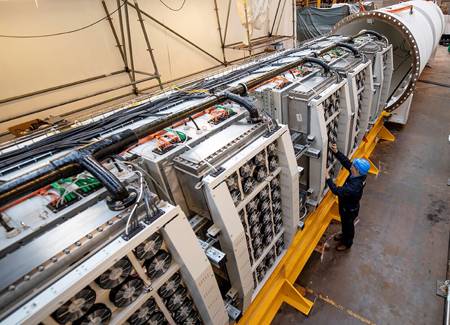Posted by: TAZ Networks on October 9, 2020 at 12:00 pm

A good place to store your 5 million movies? How about processing COVID‑19 vaccine research instead? The interior of Microsoft’s Project Natick, while under construction in France.
We’ve all had those days when we’d like to gently tuck our computer into the car, take it for a nice long drive to the Lake Michigan shore, and chuck it off a pier.
Well, Microsoft did something almost like that — but not out of frustration. Instead, Project Natick is an experiment to see if data centers can be improved by locating them underwater.
Yes, underwater. In the actual ocean.
The whole thing started as a “what if?” idea proposed by a Microsoft employee back in 2013. More than half of the world’s population lives within 120 miles of the coast. While we think data travels pretty fast already, putting datacenters nearer to most of the world’s population could improve web surfing, video streaming and game playing even more.
In addition, standard datacenters face many threats that can cause data corruption: humidity, temperature fluctuations, bumps from humans doing maintenance. Even oxygen can corrode disks and render data irretrievable. A sealed container on the ocean floor that didn’t need maintenance for 5 years? It sounded like an excellent solution.
Microsoft’s first test for Project Natick was successfully conducted over several months in 2015, off the California coast. Once phase 1 was complete, the team decided on some larger parameters for the next test. These included a full-size, full-capability data center, harsher ocean conditions, and 100% renewable energy.
Phase 2: Project Natick Northern Isles
In June 2018, the Project Natick team placed a vessel the size of a shipping container into water 118 feet deep off the rugged coast of Scotland. Fully kitted out just like a land-based datacenter, the vessel contained networking, electrical and cooling systems, and environmental monitoring equipment. The processing power included 864 standard Microsoft datacenter servers on 12 racks. That’s 27.6 petabytes, or enough to store about 5 million movies! The massive amount of energy for the project came from 100% locally produced renewable electricity, including wind, solar, tides and waves.
Over the next two years, 18 different groups at Microsoft tested the datacenter’s capabilities. While the project continued, the datacenter was re-tasked into processing data for COVID-19 vaccine research.
The two-year test completed in July this year, and the preliminary findings are encouraging for the future of sustainable and more efficient computing. After all, the servers in Natick Northern Isles showed a failure rate of 1/8th that of a land-based control group, despite the harsh sea conditions of the Scottish coast.
What Microsoft’s Project Natick Means for Small Businesses
Now. Our silly headline aside, obviously we cannot go to our backyards and submerge servers in a local lake or pool and get the same results. But what this means for you is the potential for more faster, more efficient, more reliable cloud-based computing. Microsoft’s next steps for Project Natick including studying how to scale up underwater datacenters to power the full suite of Microsoft Azure cloud services.
Interested in learning more about moving your computer network to the cloud? Make an appointment with TAZ Networks today.
Read more about Microsoft’s Project Natick here.